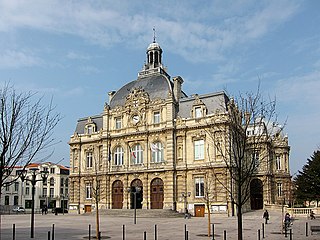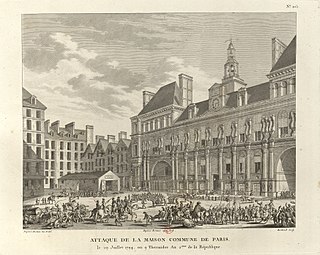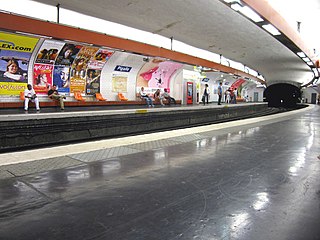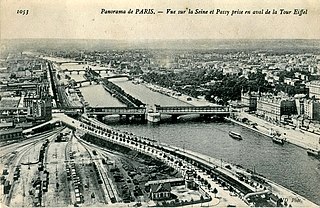
Montmartre is a large hill in Paris's 18th arrondissement. It is 130 m (430 ft) high and gives its name to the surrounding district, part of the Right Bank in the northern section of the city. The historic district established by the City of Paris in 1995 is bordered by rue Caulaincourt and rue Custine on the north, rue de Clignancourt on the east, and boulevard de Clichy and boulevard de Rochechouart to the south, containing 60 ha. Montmartre is primarily known for its artistic history, the white-domed Basilica of the Sacré-Cœur on its summit, and as a nightclub district. The other church on the hill, Saint Pierre de Montmartre, built in 1147, was the church of the prestigious Montmartre Abbey. On August 15, 1534, Saint Ignatius of Loyola, Saint Francis Xavier and five other companions bound themselves by vows in the Martyrium of Saint Denis, 11 rue Yvonne Le Tac, the first step in the creation of the Jesuits.

Tourcoing is a city in northern France on the Belgian border. It is designated municipally as a commune within the department of Nord. Located to the north-northeast of Lille, adjacent to Roubaix, Tourcoing is the chef-lieu of two cantons and the fourth largest city in the French region of Hauts-de-France ranked by population with about 97,000 inhabitants.

Pigalle is an area in Paris around the Place Pigalle, on the border between the 9th and the 18th arrondissements. It is named after the sculptor Jean-Baptiste Pigalle (1714–1785).

The Paris Commune during the French Revolution was the government of Paris from 1789 until 1795. Established in the Hôtel de Ville just after the storming of the Bastille, it consisted of 144 delegates elected by the 60 divisions of the city. Before its formal establishment, there had been much popular discontent on the streets of Paris over who represented the true Commune, and who had the right to rule the Parisian people. The first mayor was Jean Sylvain Bailly, a relatively moderate Feuillant who supported constitutional monarchy. He was succeeded in November 1791 by Pétion de Villeneuve after Bailly's unpopular use of the National Guard to disperse a riotous assembly in the Champ de Mars.

The September Massacres were a series of killings of prisoners in Paris that occurred in 1792, from Sunday, 2 September until Thursday, 6 September, during the French Revolution. Half the prison population of Paris, between 1,176 and 1,614 people, were killed by fédérés, guardsmen, and sans-culottes, with the support of gendarmes responsible for guarding the tribunals and prisons, the Cordeliers, the insurrectional commune, and the revolutionary sections of Paris.

Pigalle is a station on lines 2 and 12 of the Paris Métro, named after the Place Pigalle, which commemorates the sculptor Jean-Baptiste Pigalle (1714–1785) on the border of the 9th and the 18th arrondissement. The station is located under the Boulevard de Clichy in Montmartre and serves the famous Pigalle red-light district.

Passy is an area of Paris, France, located in the 16th arrondissement, on the Right Bank. It is home to many of the city's wealthiest residents.

The Insurrection of 10 August 1792 was a defining event of the French Revolution, when armed revolutionaries in Paris, increasingly in conflict with the French monarchy, stormed the Tuileries Palace. The conflict led France to abolish the monarchy and establish a republic.

Henri Lefebvre was a French Marxist philosopher and sociologist, best known for pioneering the critique of everyday life, for introducing the concepts of the right to the city and the production of social space, and for his work on dialectical materialism, alienation, and criticism of Stalinism, existentialism, and structuralism. In his prolific career, Lefebvre wrote more than sixty books and three hundred articles. He founded or took part in the founding of several intellectual and academic journals such as Philosophies, La Revue Marxiste, Arguments, Socialisme ou Barbarie, Espaces et Sociétés.

Meaux is a commune on the river Marne in the Seine-et-Marne department in the Île-de-France region in the metropolitan area of Paris, France. It is 41.1 km (25.5 mi) east-northeast of the centre of Paris.

The Café de Flore is one of the oldest coffeehouses in Paris, celebrated for its famous clientele, which in the past included high-profile writers and philosophers. It is located at the corner of Boulevard Saint-Germain and Rue Saint-Benoît, in Saint-Germain-des-Prés in the 6th arrondissement. The nearest underground station is Saint-Germain-des-Prés, served by line 4 of Paris Métro. The coffeehouse still remains a popular hang-out spot for celebrities and its status attracts numerous tourists.

The Women's March on Versailles, also known as the October March, the October Days or simply the March on Versailles, was one of the earliest and most significant events of the French Revolution. The march began among women in the marketplaces of Paris who, on the morning of 5 October 1789, were nearly rioting over the high price of bread. The unrest quickly became intertwined with the activities of revolutionaries seeking liberal political reforms and a constitutional monarchy for France. The market women and their allies ultimately grew into a mob of thousands. Encouraged by revolutionary agitators, they ransacked the city armory for weapons and marched on the Palace of Versailles. The crowd besieged the palace and, in a dramatic and violent confrontation, they successfully pressed their demands upon King Louis XVI. The next day, the crowd forced the king, his family, and most of the French Assembly to return with them to Paris.

Nathalie Lemel, was a militant anarchist and feminist who participated on the barricades at the Commune de Paris of 1871. She was deported to Nouvelle Calédonie with Louise Michel.
The Cours Florent is a private French drama school in Paris established in 1967 by François Florent.

The Boulevard de Clichy is a famous street of Paris, which lends its name to the Place de Clichy, resulted from the fusion, in 1864, of the roads that paralleled the Wall of the Farmers-General, both inside and out. It extends from the Place de Clichy to the Rue des Martyrs, nearly a kilometre away. During its tenure, the street has been known as the Boulevard des Martyrs, then the Boulevard Pigalle, and, finally, the Boulevard de Clichy. It is equally well known as the Boulevard Clichy.

Christer Strömholm, also known by the pseudonym Christer Christian, was a Swedish photographer and educator. He is known for his intimate black and white street photography portrait series, particularly his portraits of transgender women in Paris. Strömholm received the 1997 Hasselblad Award.

Union des femmes pour la défense de Paris et les soins aux blessés was a women's group during the 1871 Paris Commune. The union organized working women, ensured a market and fair pay for their work, and participated in the defence of Paris against the troops of the Third Republic, particularly at Place Blanche.

Blanche Lefebvre was a communard active in the Batignolles quarter in the 12th arrondissement of Paris. She died defending the Paris Commune during "bloody week".
Béatrix Excoffon, born Julia Euvrie or Œuvrie was a militant communard who served as an ambulance nurse during the Commune of Paris in 1871. She was vice-president of the Club des Femmes de la Boule Noire, and was known as "the republican".
The Paris Commune was an insurrectionary period in the history of Paris that lasted just over two months, from March 18, 1871 to the Semaine sanglante that ended on May 28, 1871. This insurrection refused to recognize the government of the National Assembly of 1871, which had just been elected by universal male suffrage. Many women took active roles in the events, and are known as "communardes". They are important in the history of women's rights in France, particularly with regards to women's emancipation. Equal pay and the first forms of structured organization of women in France appear during this period, in particular the Union des femmes pour la défense de Paris et les soins aux blessés or the Comité de vigilance de Montmartre.
















